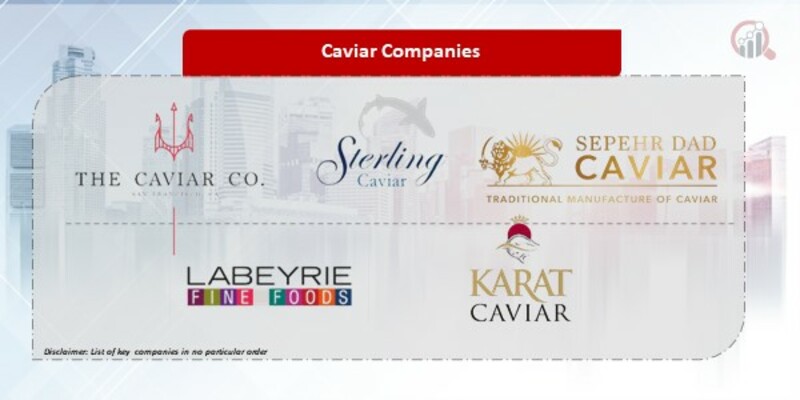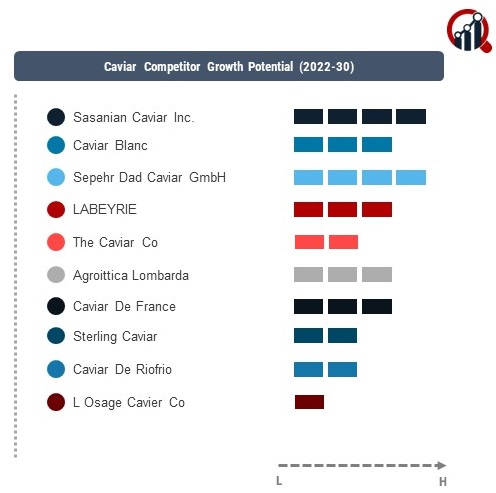Caviar Companies
Caviar is a delicacy consisting of salt-cured fish roe, typically from sturgeon. Known for its luxurious flavor and texture, caviar is often enjoyed as a garnish or appetizer.


Caviar is a delicacy consisting of salt-cured fish roe, typically from sturgeon. Known for its luxurious flavor and texture, caviar is often enjoyed as a garnish or appetizer.

The Caviar Market, characterized by its exclusivity and gourmet appeal, is influenced by key players, their strategies, market share determinants, emerging companies, industry news, investment trends, and the overall competitive scenario in 2023.
Key Players:
Karat Caviar
Caviar CreatorInc.
Caviar Blanc
Sepehr Dad Caviar GmbH
Labeyrie
The Caviar Co
Caviar House
California Caviar Company
Sterling Caviar
Sasanian Caviar Inc
Agroittica Lombarda
Strategies Adopted:
To maintain a competitive edge in the Caviar Market, key players employ distinct strategies that align with the market's exclusivity and demand for high-quality products.
Species Diversification: Key players strategically diversify their caviar offerings by focusing on various sturgeon species, including Beluga, Osetra, and Sevruga. This strategy enables companies to cater to different flavor preferences and market segments.
Sustainable Practices: Sustainability is a key focus for players in the Caviar Market. Sustainable sturgeon farming practices, including aquaculture, contribute to the conservation of wild sturgeon populations and align with the growing consumer preference for environmentally responsible products.
Global Market Expansion: Expanding market presence internationally is a common strategy among key players. Strategic partnerships, exclusive collaborations, and distribution agreements help companies tap into new markets and cater to a broader clientele.
Brand Positioning: Brand image and positioning are paramount in the Caviar Market. Key players invest in building and maintaining a reputation for excellence, emphasizing factors such as product quality, ethical sourcing, and adherence to traditional production methods.
Market Share Analysis:
The exclusivity and luxury nature of caviar contribute to specific factors that influence market share dynamics within this niche segment.
Quality and Flavor Profile: Market share is heavily influenced by the quality and flavor profile of the caviar offered. Companies that consistently deliver caviar with a superior taste, texture, and appearance secure a larger market share.
Sustainability Credentials: Given the increased focus on sustainability, companies that can showcase strong sustainability credentials in their caviar production processes gain favor among environmentally conscious consumers, impacting market share.
Brand Heritage: Established brand heritage and a rich history in caviar production contribute significantly to market share. Consumers often associate certain brands with authenticity, tradition, and uncompromising quality.
Distribution Channels: Accessibility through diverse distribution channels, including luxury retailers, fine dining establishments, and exclusive online platforms, influences market share. A robust and well-managed distribution network ensures that caviar products are readily available to consumers.
News & Emerging Companies:
News within the Caviar Market often revolves around sustainable farming practices, new product launches, and collaborations that enhance the industry's profile.
Emerging companies focus on introducing innovative caviar products, often exploring unique flavor profiles or experimenting with sustainable farming methods. These companies strive to establish themselves in a market dominated by established players.
Industry Trends:
Investment trends within the Caviar Market reflect the industry's commitment to sustainability, technological innovation, and the preservation of traditional production methods.
Technological Innovation: Investments in technology aim to enhance the efficiency of sturgeon farming, ensuring optimal conditions for the growth and well-being of the fish. This includes the use of advanced monitoring systems and aquaculture technologies.
Sustainability Initiatives: Ongoing investments in sustainable practices, such as closed-loop aquaculture systems, highlight the industry's dedication to environmental responsibility. Companies strive to balance production with conservation efforts to secure the long-term viability of caviar production.
Traceability and Transparency: Investments in traceability and transparency initiatives, including the use of blockchain technology, address consumer concerns regarding the authenticity and sourcing of caviar products. This contributes to consumer trust and loyalty.
Competitive Scenario:
The Caviar Market is defined by an exclusive and competitive landscape where key players vie for market share through a combination of product excellence, sustainability practices, and strategic market expansion. The market's limited but discerning consumer base demands a high level of quality and authenticity from its caviar providers.
Recent Development
The Caviar Market was the industry's collective effort to address environmental concerns through sustainable aquaculture practices. Key players collaborated on initiatives to further reduce the environmental impact of sturgeon farming, emphasizing the importance of long-term ecological balance in caviar production. This development underscores the industry's commitment to sustainability, aligning with consumer expectations for ethically sourced and environmentally responsible luxury food products.

Caviar Market Highlights:
© 2025 Market Research Future ® (Part of WantStats Reasearch And Media Pvt. Ltd.)